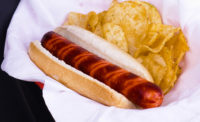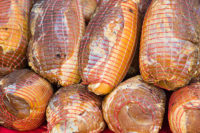Packaging Tech
Options for casings, nettings expand

Sausage is eaten all over the world. According to the International Natural Sausage Casing Association, Alexandria, Egypt, it’s the oldest and most enduring form of processed meat.
In the beginning, sausage relied on natural casings — the intestines of animals — but today options have expanded and natural casings have been joined by collagen, cellulose, fibrous and plastic options, plus plant-based alginate, which is coextruded along with the meat.
Despite a wider array of choices, many sausage makers large and small continue to rely on natural casings. Norm Heinle, owner of The Sausage Shoppe, a Cleveland, Ohio, icon that’s been in business since 1938, uses beef, sheep and hog casings for both traditional and self-developed recipes.
Hog and sheep casings dominate at the Sausage Shoppe, although beef rounds are used for rice sausage. The sheep casings are narrower in diameter, ranging from 20 to 27 millimeters (mm), and usually come from New Zealand.
“I don’t think we have anyone cleaning casings any more in the United States,” Heinle says. Sheep casings are classified Class A or Class B. Heinle reports, “We use Class A, which offers a smoother surface.” The sheep casings provide a tender “skin” for Sausage Shoppe’s premium smokies, breakfast links and German wieners. “We have 15 flavors of smokies now. Everyone wants on-the-go products,” he notes.
Hog casings, which are a bit tougher and offer a larger diameter than sheep casings, are used for the company’s 25 flavors of bratwurst. The bratwurst range consists of traditional old-world recipes as well as many award winners developed during the past 20 years. Flavors range from mild white traditional brats to medium Honey Chipotle and hot Cherry Bomb. “We’re trying to keep it going with new ideas and flavors,” Heinle says. A 35-38 mm hog casing is used for smoked and fresh kielbasi and Italian sausage. For maximum tenderness, Heinle advises frying products in hog casings, or putting the product in cold water, bringing it to a boil and then simmering.
Why natural casings? “This is the way we’ve always done it,” says Heinle, who bought the business, then known as Kirchberger Sausage, in 1974 and still uses recipes Hans Kirchberger brought from Bavaria. “It’s what our customers expect,” he explains. Although The Sausage Shoppe customers are willing to pay for a premium product, costs are a constant concern. As a result, inventory must be carefully controlled. So although natural casings have a relatively long shelf life, Heinle deals with vendors that specialize in smaller volume orders. Being locked into a large minimum order quantity ties up too many resources in inventory for a small business.
Compared to casing, netting plays a small role at The Sausage Shoppe. It’s only used on its Sheffler hams to maintain their shape during smoking. Here too, tradition rules. “We use a cotton weave and soak it in vinegar for about an hour before we put the ham in it,” says Heinle. The vinegar treatment ensures that when the ham is done smoking, the netting peels off easily and doesn’t tear off any skin.
When asked about the biggest changes he’s seen in casing and netting, Heinle cites the development of materials treated with spices or flavorings to create products that offer a different taste profile. While he finds the idea intriguing, he says, “The majority or our customers like natural casings, so that’s where we’ve stayed.”
The flavored casings are not the only innovation casing and netting suppliers have introduced in recent years. Another product-differentiating alternative, shaped fibrous casings, allows sausage makers to move beyond the traditional cylindrical form. Options currently on the market include football and beer bottle shapes.
On the netting side, there appears to be some interest in replacing fibrous and plastic casings with elastic netting. A pre-fixed diameter maximizes uniformity, reduces variation in slice size and increases slicing yield for whole muscle and emulsified ham. NP
Looking for a reprint of this article?
From high-res PDFs to custom plaques, order your copy today!






